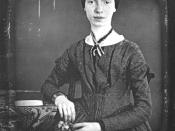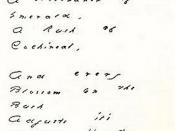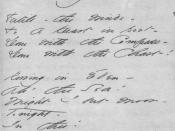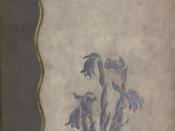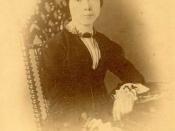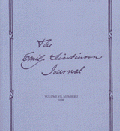"Because I Could Not Stop for Death" was written by Emily Dickinson in 1863. She was thirty-three years old. The loss of friends and family made death a powerful subject in Emily's mind. This poem is a reflection of her effort to understand and cope with the mystery of death. An excerpt from the book "Heaven Beguiles the Tired : Death in the Poetry of Emily Dickinson" supports this theory by stating "The remark to her Norcross cousins that she "sang off charnel steps" ( II, 436) is a further indication that the poet herself knew that death, and more particularly a fear of it, was a prime motivating force in her creative work."(Ford, p. 176) Emily Dickinson shows the reader a unique view on life, death and immortality in "Because I Could Not Stop for Death".
The first stanza introduces the three characters in this poem.
The speaker appears preoccupied with her own concerns when "Death"(1) arrives. "Death"(1) is personified as a "kindly"(2) gentleman. He stops for the speaker when she "could not stop"(1) for him. The tone of the first three stanzas is calm and matter of fact. The speaker is not frightened by "Death"(1), but describes him as if he is a friend. It is ironic that the speaker joins him in the carriage, which is symbolic for a hearse. Death is usually seen as something both somber and terrifying, yet she joins him as she would a suitor. "Immortality"(4) is mentioned in the last line of this stanza as the third passenger, but is given no physical or emotional description. This may demonstrate that "Immortality"(4) is too ethereal of a concept to compose into a solid character.
The tone continues to be mild and somewhat reassuring in the second stanza. The speaker describes the carriage traveling "slowly"(5). "Death"(1) is once again portrayed as patient and considerate with these words "He knew no haste"(5). The reader may have the sense that "Death"(1) knows something that the speaker does not. Therefore, he is in no hurry to arrive at a destination. Alliteration is used throughout the poem. The first instance is in the words "labor"(7) and "leisure"(7).These words portray the speaker's effort to put away the cares of life in deference to her journey with "Death"(1). She remarks on "His Civility"(8). End rhyme ties the words "Immortality"(4), "Civility"(8) and "Eternity"(24) together.
The lines of the third stanza represent the cycle of life and death. The word "passed" (9-11-12) is mentioned in three lines of this stanza. The use of this word reminds the reader of the speaker's awareness of her own mortality. A beginning of life is symbolized in the first line with "children"(9) striving or playing at "School"(9). The "Ring"(10) symbolizes the never ending circle of life. The latter season of life is depicted with the alliteration "Gazing Grain"(11). Another alliteration, "Setting Sun"(12) signifies that the speaker's journey is nearing an end.
Halfway through the poem, in the fourth stanza to be exact, the tone changes. The speaker realizes that she is no longer moving forward. She is surprised as the "Setting Sun"(12) passes the occupants of the carriage. This happens in the thirteenth line of the poem, a number that is sometimes given supernatural connotations. Line fourteen reveals the speakers realization that she has in fact died. A feeling of coldness is expressed with the words "The Dews Drew quivering and chill"(14). She appears unprepared for her passing as she describes her attire in the third line of this stanza, "only Gossamer, my Gown"(15). She is dressed lightly, and the "Tulle"(16) of her "Tippet"(16) may suggest a bridal veil. Death is portrayed as the final bridegroom.
The fifth stanza describes the speaker's impression of her final destination. Her carriage "paused"(17) in front of a "House"(17). A home has positive connotations of warmth and security. The next line reveals that the home she speaks of is actually a grave, as "A swelling of the Ground"(18). She goes on to describe what appears to be a coffin with these words, "The Roof was scarcely visible"(19). A dramatic pause follows the words" Cornice"(20) and "Ground"(20). This signifies the final end to her journey with "Death"(1) and leaves the speaker with no doubt as to where her final resting place will be.
Impressions of time and infinity are described in the final stanza of this poem. The author uses hyperbole to describe the speaker's impression of the time that has elapsed during her carriage ride. The words "'Tis Centuries"(21) suggest that death has no sense of time. What felt like a day to the speaker was in fact hundreds of years in the world of the living. Eye rhyme is used with the words "Day"(22) and "Eternity"(24). Tying the two concepts togther, the speaker's "Day"(22) is actually an "Eternity"(24).
Emily Dickinson's own experience with the passing of family and friends around her made death a prevalent character in her writings. She lost several of her closest schoolmates to consumption (Voices and Visions). One of her favorite tutors passed away unexpectedly while she was still quite young. Ankey Larrabee writes: "Death had possessed too many of her friends to be reckoned with as a complete abstraction"( Accent p. 115-117). In one of her many letters to T.W. Higginson Emily writes: "I sing, as the Boy does by the Burying Ground--because I am afraid" (Ford p. 176) I believe that Emily Dickinson's fear of death, and the unknown hereafter is what fueled her copious writings on the subject. Over one third of her impressive body of work (over 1700 poems) is about, or related to death(Voices and Visions). Emily herself passed away in 1886, at the age of fifty- six. One can surmise that Emily's questions on death were finally answered. Hopefully, her fears were laid to rest just as her earthly body was on a sunny spring day in 1886.
Ford, Thomas W. Heaven Beguiles the Tired : Death in the Poetry of Emily Dickinson University Alabama. University of Alabama Press, 1966 Larrabee, Ankey. "three Studies in Modern Poetry." Accent, III Winter:1943 115-117
